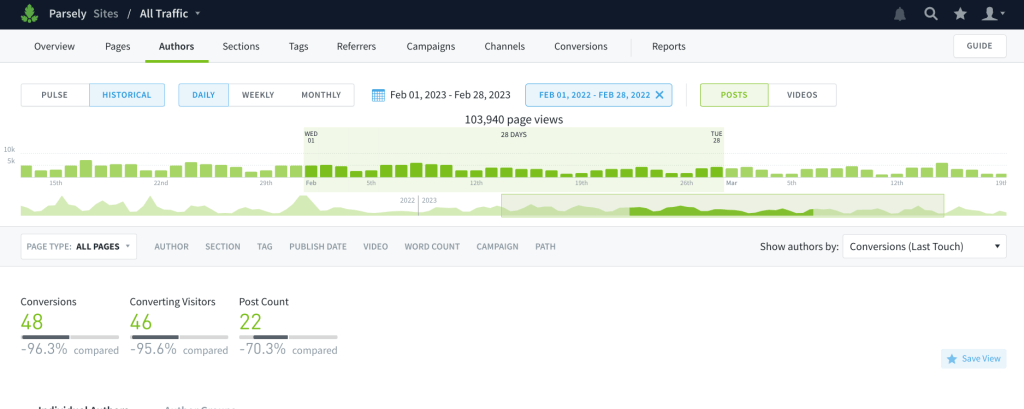5 Steps for Measuring AI Content Performance

Artificial Intelligence (AI) is transforming the world of content creation. With more AI-assisted content generation tools dotting the martech landscape, it’s crucial for publishers and marketers to measure the effectiveness of AI-generated content and determine if it’s worth integrating into your content strategy.
Enter Parse.ly—a powerful content analytics tool designed to track and gauge content performance. Let’s dive into the six-step process to use the Parse.ly dashboard to evaluate AI’s impact on your content.
- Set performance goals
- Tag AI-assisted content
- Use the Parse.ly dashboard for analysis
- Compare AI content to overall post performance
- Identify best practices to optimize your content strategy
Step 1: Set performance goals
Establish clear goals for your AI-assisted content. Common goals include increasing pageviews, improving engaged time, attracting attention on social channels, and generating leads. Set benchmarks based on existing content so you can easily compare the two data sets later.
Learn more about setting goals and establishing benchmarks in our Metrics for Content series.
Step 2: Tag AI-assisted content
Create a consistent tagging system for all AI-assisted content on your site. This helps you easily identify such content and track and measure its performance. As an example, you might tag all AI-assisted content with “AI assisted” or the name of the tool itself, such as “ChatGPT assisted.”

Step 3: Use the Parse.ly dashboard for analysis
Once you’ve established your AI tagging and publishing process, use the Parse.ly dashboard to analyze and compare the tagged AI-assisted content with your manually created content.
Focus on the performance metrics aligned with your goals established in Step 1. For example, if you are targeting lead generation, look at conversions under the Conversions tab in the dashboard. There, you can filter by your AI-assisted tag to view the conversions associated with AI tags.

Step 4: Compare AI content to overall post performance
By benchmarking tagged AI-assisted content with the rest of your content, you can identify how well your AI-assisted content is performing against your goals. Use the data collected and analyzed by Parse.ly to understand how AI content affects user behavior, engagement, and traffic, and make sure you’re not sacrificing quality or impact for time saved.
Depending on your goals, there are multiple ways inside the Parse.ly dashboard to benchmark AI content to your overall site and post performance.
For example, the Tags tab shows top-performing tags sorted by metrics you care about most, such as conversions, engaged time, or social referrals. Find where your AI-assisted content excels and where it falls short, and use that information to refine your content strategy.
In the Tags tab, you can also use comparison mode to assess performance across two different time periods and choose the tags you want to display. This allows you to monitor and benchmark the impact of your AI-assisted content over time.

The best part about the Parse.ly dashboard is the flexibility it offers when analyzing performance. No matter which tab you use, you can filter by a tag and sort by your desired metric to easily assess AI-assisted content performance.
Step 5: Identify best practices to optimize your content strategy
Continuously analyze the performance of AI-assisted content to identify patterns and best practices. Leverage these insights to refine your AI content creation process, track top-performing articles, and determine AI-assisted content that resonates with your audience.
Lastly, optimize your content strategy based on your findings, improving your AI-assisted content creation and distribution processes for better engagement, higher click-through rates, and enhanced reader conversion.
For example, if you notice your AI-assisted content has higher rates of search referrals than other content, revisit older pieces and use AI to generate stronger headlines or meta descriptions to boost SEO performance.
Or maybe you’ll learn that your AI-assisted content does a great job driving traffic from social, but less so converting readers to subscribers. Adapt accordingly—focus your most experienced writers on content geared toward conversion, and leave the social media content to your AI assistant.
Bake this approach into your publishing strategy, and find ways to repurpose that top-performing content.
Keep improving with Parse.ly
AI-assisted content holds great potential for content creators. Parse.ly offers a fantastic way to measure the effectiveness of this rapidly growing content creation method. By following these steps and utilizing the analytical capabilities of Parse.ly, marketers and publishers can truly harness the power of AI for business growth and success.
Fun fact: This article was written by ChatGPT (and edited by our team for accuracy, of course). We’ll be practicing what we preach and monitoring its performance against other, non-AI influenced content.